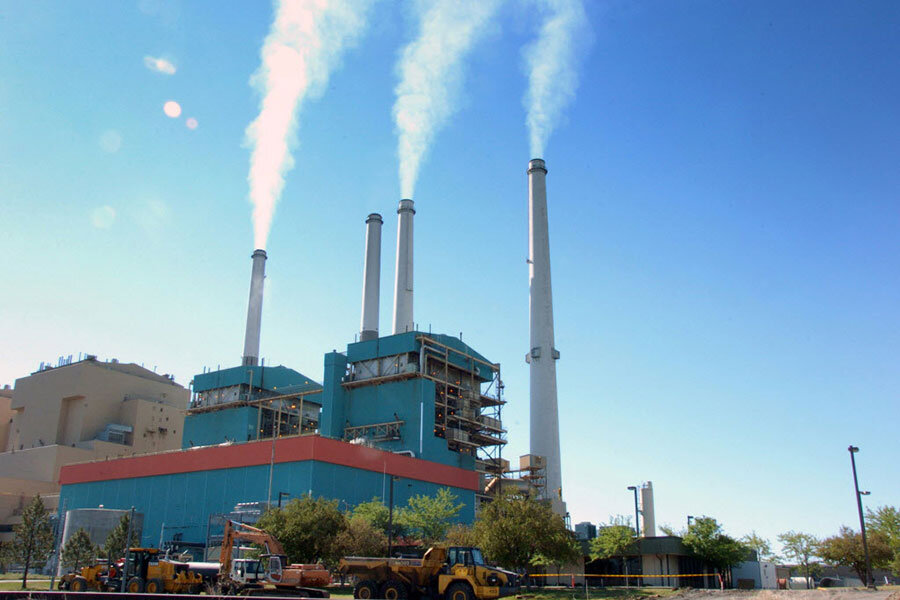How America is quietly becoming a climate change leader
Loading...
When it comes to the fight against climate change, the United States is often cast as a laggard – if not an outright pariah.
But that portrait is quietly changing.
On one hand, the fundamentals of America’s conflict over the human role in climate change remain unchanged. A cap-and-trade bill to reduce carbon emissions remains a nonstarter in Congress, and 41 percent of Americans say global warming has more to do with natural causes than human activity, according to Gallup.
But executive actions by the Obama administration, combined with a host of new laws in key states, mean that the United States is actually already taking significant action against climate change. Not only are these actions making an appreciable dent in the country’s greenhouse gas emissions, they are beginning to change how other countries see America’s leadership on the issue.
"The fact that the US is taking these issues more seriously than we were doing five years ago, that means other countries are going to take it seriously as well," says Richard Revesz, director of the Institute for Policy Integrity at the New York University Law School.
President Obama has made climate change a focus of his second term agenda and a cornerstone of his legacy as a whole. But facing opposition in Congress, he has turned to executive action and regulation, principally through the Environmental Protection Agency (EPA).
Mr. Obama's stated emissions pledge – made in partnership with China last winter – is to cut carbon emissions to 26 to 28 percent of 2005 levels within the next decade. The pledge is tied to the Clean Power Plan (CPP) – a suite of new EPA regulations to limit greenhouse gas emissions from US power plants. It is expected to go into effect later this summer.
But what makes the CPP feasible, experts say, is what states have already been doing.
“States have been leading the way for a long time in terms of clean energy,” says Elizabeth Ouzts, a spokeswoman for Environment America, an environmental advocacy group.
Seven states have adopted broad caps on emissions, and 28 states have introduced renewable energy requirements, according to a recent report from Environment America. According to the report, state and federal policies currently in action or about to go into action – including the CPP – can hit the targets laid out in the China deal.
"The path has been paved with state-level success and ambition, and the Clean Power Plan directly rose from the success we’ve seen at the state level," says Anna Aurilio, director of the Global Warming Solutions program at Environment America.
She says incidents of extreme weather, such as hurricane Sandy and the ongoing drought in California, have served as wakeup calls.
"People are starting to connect the dots between extreme weather events and the need to act on climate change," she says.
The first of several deadlines to comply with the CPP standards is 2020, and most states are already two-thirds of the way toward compliance, says Kenneth Kimmell, president of the Union of Concerned Scientists. [Editor's note: The original version of this story misspelled Mr. Kimmell's name.]
"Most states will exceed that 2020 timeline just based on what they’ve already done," he adds. "We do think states are poised to cost-effectively and successfully comply with the Clean Power Plan."
That means that American negotiators should be able to walk into the United Nations climate change conference in Paris this December with some momentum.
"We always believed that when the US took action domestically it could lead the rest of the world, and that’s in fact what we’re seeing," says Ms. Aurilio of Environment America.
The agreement between China and the US – the world's No. 1 and 2 polluters, respectively – helped give America more credibility on the world stage. And the CPP helped give America credibility with China.
"We wouldn’t have gotten the commitment from China if hadn’t looked like we were about to implement Clean Power Plan," says Mr. Kimmell of the Union of Concerned Scientists. "I think our seriousness will result in positive action by other countries."
He adds that he was in Sweden and Denmark recently, talking with people involved in international climate negotiations.
"There's a recognition that it's real," he says, referring to US action on reducing carbon emissions.
Many challenges remain, however. On Monday, the US Supreme Court ruled that the EPA improperly streamlined the regulation process when it established new standards for emissions of mercury and other toxic substances.
The EPA says the ruling “does not affect the Clean Power Plan.” But others say it throws the EPA’s entire regulatory regime into question. Senate majority leader Mitch McConnell (R), who comes from the coal-producing state of Kentucky, said the ruling affirmed his advice to state governors to ignore the new power plant regulations.
Regardless of the varying interpretations of Monday's ruling, the CPP is likely to face both legal and legislative challenges. And the US can’t think that the CPP is enough, says Aurillo.
To keep global temperatures from rising 2 degrees Celsius – the consensus scientific target for preventing the worst consequences of global warming – the US must cut its carbon emissions at least 80 percent below 1990 levels by mid-century.
"We should’ve got started with all these steps 20 years ago; the fact we’re taking them on now means we’re going to have to work harder," she says.
But she sees reason to hope.
"We’ve seen countries like China, that have never before constructively engaged, come to the table," she adds. "This is a very hopeful time in what has otherwise been a pretty long period of very little action and progress on the global front, so this is huge.”








